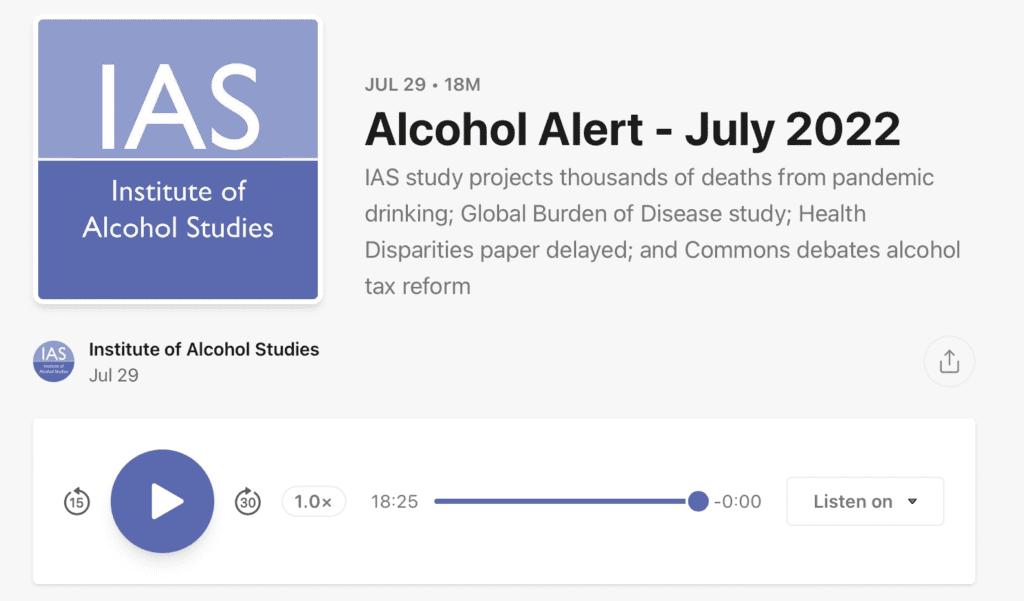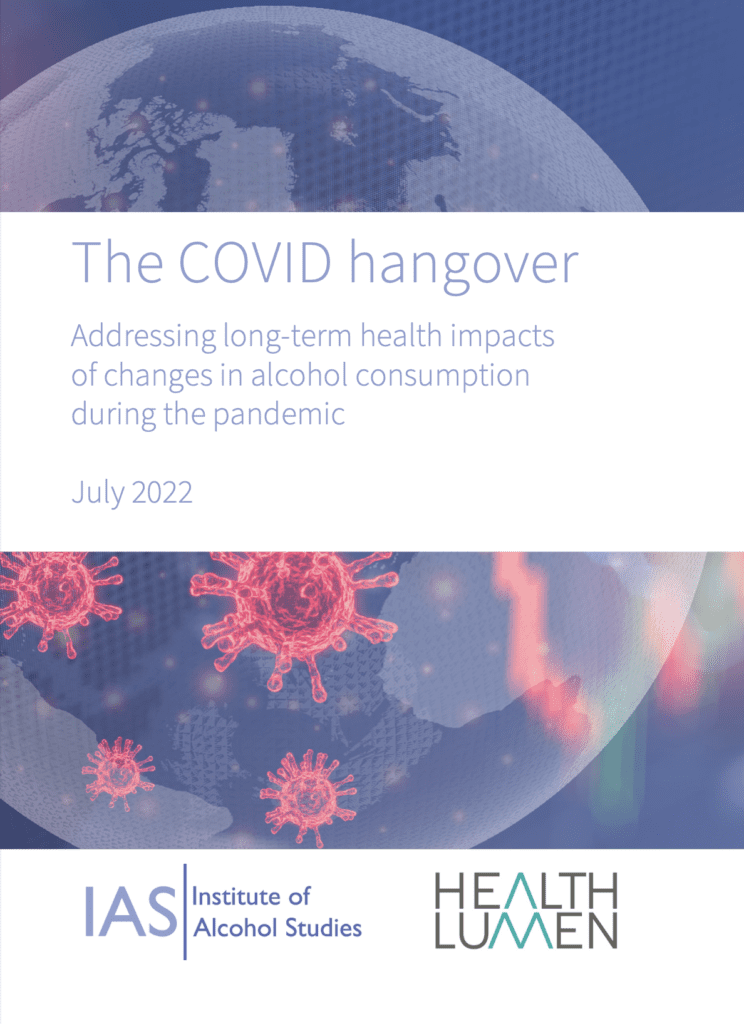Two new reports from England illustrate the need for urgent alcohol policy action in the UK. The rise in alcohol use among heavy users during the COVID-19 pandemic could lead to drastic long-term consequences, including increased alcohol-related disease, hospital admissions, premature deaths and costs to the NHS.
The two reports model various scenarios each on how alcohol harm could rise in England due to the impact of COVID-19.
- One report was published by The University of Sheffield and commissioned by NHS England & NHS Improvement.
- The other report was published by the Institute of Alcohol Studies (IAS) and Health Lumen.
Overall findings of the reports
Both reports find alcohol use among lower-risk alcohol users or people who were consuming alcohol within the low-risk alcohol use guidelines in the UK declined during the COVID-19 pandemic. However, alcohol use among higher-risk alcohol users – specifically heavy users – increased the most during the pandemic. This pattern is lasting beyond the national lockdowns in 2020 and 2021, indicating long-term alcohol harm could rise.
Results are likely under-estimations and omit secondhand harm due to alcohol
Both studies modeled various scenarios in how the trends could continue and how that would affect alcohol harm in England. However, the IAS study only took nine diseases into consideration and modeled three scenarios. The Sheffield study took 42 diseases into consideration and modeled five scenarios across 20 years. That’s why the IAS study provides more conservative results. Considering there are about 200 diseases linked to alcohol use, the reality is bound to be far more serious than predicted by either of the studies.
The results of the studies are in line with the recent increases in alcohol-related deaths seen in England. There was an almost 20% increase in alcohol-specific deaths in England in 2020 compared with 2019, and this trend persisted through 2021.
There have also been changes to access to treatment and services for alcohol problems during the pandemic. This means there are possibly other increased harms that are less visible. Neither of the studies has measured the level of alcohol harm to others that may increase as a result of the COVID-19 pandemic’s effect on alcohol use.
Best and worst case scenarios
The studies predict that in the best-case scenario additional cases of alcohol-related disease/ hospitalizations could rise between 2,860 to 42,677; and alcohol deaths could rise between 1,830 to 2,431; and the cost to the NHS could increase between £200 million to £363 million.
In the worst-case scenario, additional cases of alcohol-related disease/ hospitalizations could rise between 147,892 to 972,382; and alcohol deaths could rise between 9,914 to 25,192; and the cost to the NHS could increase between £1.2 billion to £5.2 billion.
These figures highlight that the pandemic’s impact on our [alcohol use] behavior is likely to cast a long shadow on our health and paint a worrying picture at a time when NHS services are already under huge pressure due to treatment backlogs,” said Colin Angus, a senior research fellow at The University of Sheffield, and lead researcher of the study, as per The Guardian.
Colin Angus, senior research fellow, The University of Sheffield
Both studies found the estimated rising alcohol harms also will increase health inequalities in England. People with heavier alcohol use and those in the most deprived areas, who already suffer the highest rates of alcohol harm, are expected to be disproportionately affected.
Our study projects that if alcohol consumption stays at current levels … inequalities in deaths from alcohol will also grow wider than they already are,” said Sadie Boniface, head of research at the Institute of Alcohol Studies (IAS), and joint lead of the study as per The Guardian.
The results of the studies should be a wake-up call to take action.”
Sadie Boniface, head of research, the Institute of Alcohol Studies (IAS)
Key findings from the University of Sheffield study
In the main scenario modeled by the researchers, lower-risk alcohol users would go back to pre-pandemic (2019) levels of alcohol use from 2022. People with heavier alcohol use remain at their pandemic levels for a further five years and then gradually return to pre-pandemic levels over the next five years.
In this scenario, researchers estimate that over the next 20 years, there will be an additional 207,597 alcohol-attributable hospital admissions and 7,153 alcohol-attributable deaths, costing the NHS an additional £1.1bn compared to if alcohol consumption had remained at 2019 levels.
Best-case scenario
In the best-case scenario all alcohol use goes back to pre-pandemic levels in 2022.
In this “best-case scenario”, researchers estimate:
- additional 42,677 alcohol-attributable hospital admissions; and
- additional 1,830 deaths over 20 years; and
- additional costs to the NHS of £200 million.
Worst-case scenario
In the worst-case scenario, all alcohol consumption increases in 2022 as a result of the relaxation of COVID restrictions and the opening up of pubs, bars, restaurants, and nightclubs.
In this “worst-case scenario”, researchers estimate:
- additional 972,382 alcohol-attributable hospital admissions; and
- additional 25,192 deaths; and
- additional costs to the NHS of £5.2bn over 20 years.
Key findings from the Institute of Alcohol Studies (IAS) study
The IAS study took nine diseases into consideration. These includ hypertension, liver cirrhosis, stroke, and six cancers: breast cancer, colorectal cancer, liver cancer, mouth cancer, oesophageal cancer, and throat cancer.
The study modeled three scenarios and estimated alcohol harm by 2035.
- Short-term scenario: Alcohol consumption returns to 2019 levels after 2022.
- Medium-term scenario: Alcohol consumption returns to 2019 levels after 2024.
- Long-term scenario: Alcohol consumption does not return to 2019 levels
Short-term/ best-case scenario
- 2,860 additional cases of alcohol-related disease.
- 2,431 additional premature deaths caused by alcohol.
- £363 million additional costs to the NHS.
Medium-term scenario
- 24,706 additional cases of alcohol-related disease.
- 3,725 additional premature deaths caused by alcohol.
- £568 million additional costs to the NHS.
Long-term/ worst-case scenario
- 147,892 additional cases of alcohol related disease.
- 9,914 additional premature deaths caused by alcohol.
- £1.2 billion additional costs to the NHS.
These increases in alcohol harm, lives lost, and costs to the NHS projected in our study are not inevitable,” said Sadie Boniface, head of research at the Institute of Alcohol Studies (IAS), and joint lead of the study as per NIHR.
Deaths from alcohol are at record levels, and this research should act as a ‘wake-up call’ to take alcohol harm seriously as part of recovery planning from the pandemic.”
Sadie Boniface, head of research, the Institute of Alcohol Studies (IAS)
The IAS study concludes that the estimated rise in alcohol harm to people and communities can be prevented as part of COVID-19 recovery planning.
There are evidence-based alcohol policy solutions that the UK government should urgently implement in order to prevent disease, save lives and improve the healthcare system for all. The World Health Organization (WHO) has recommended such cost-effective policy solutions in the “Best Buys” and the SAFER package.
The IAS report makes the following recommendations to improve UK alcohol policies.
A new national alcohol strategy for England is needed, with the following evidence-based policies taking priority:
- Increase funding and resources for alcohol treatment and support, over and above what is promised in the new Drug Strategy, based upon anticipated need.
- Alongside this, increase resources for primary and secondary prevention, such as screening and brief interventions.
- Capitalize on the opportunities presented by the new alcohol duty system commencing in 2023. The principle of a strength-based system is welcome, but duty rates should be consistent across different categories and must automatically increase in line with inflation.
- Introduce minimum unit pricing for alcohol. This would align England’s policy with Scotland and Wales.
- Regarding the minimum price level, others have recommended that Scotland uprates their minimum price to 65p per unit.
- Add protecting and improving public health as a fifth objective of the alcohol licensing system in England, as it is in Scotland.
- This will enable health more broadly to be part of local decision-making on alcohol availability.
- Improve the regulatory approach to alcohol marketing to reduce exposure and influence among the vulnerable.
Listen to the IAS podcast on both studiesm featuring Colin Angus, a senior research fellow at The University of Sheffield and Sadie Boniface, head of research at the Institute of Alcohol Studies (IAS).

Sources
The Guardian: “Lockdown drinking increase could cause 25,000 excess deaths in England“
BBC: “Alcohol deaths from pandemic drinking are predicted to rise“
nhe: “New study shows possibility of extra 150,000 diseases and £1bn of damages“
Mirror: “Covid pandemic increased binge drinking with a surge of hospital admissions expected“

